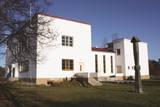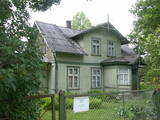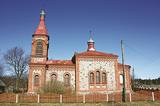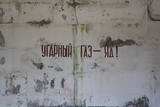| Nr | Nosaukums | Apraksts |
|---|---|---|
|
Atpūtas komplekss Rušonas ezera ziemeļrietumu krastā ar naktsmītnes, ēdināšanas un aktīvās atpūtas pakalpojumu piedāvājumu. |
||
|
Dobeles vārds vēstures avotos pirmo reizi minēts 1254. g. Dobele bija viena no visvairāk nocietinātajām zemgaļu vietām, tādēļ laikā no 1279. - 1289. g. pārdzīvoja sešus vācu krustnešu uzbrukumus. 1289. g. zemgaļi tomēr bija spiesti atkāpties. 1335. g. iekarotāji zemgaļu pils vietā uzsāka jaunas mūra pils celtniecību. Bērzes pretējā kreisajā krastā sāka veidoties tirgotāju un amatnieku miests. Pilsēta ļoti cieta Ziemeļu kara un tam sekojošā mēra laikā. Nozīmīgs notikums pilsētas saimnieciskajā dzīvē bija 1927. g., kad izbūvēja Liepājas-Glūdas dzelzceļa līniju. Pēc 2. pasaules kara Dobelē un tās apkaimē ieradās padomju militāristi, kas izbūvēja vienu no lielākajiem PSRS tanku poligoniem „Dobele-2". Tagad Dobeles apceļotājiem tiek piedāvāts interesants apmeklējamo objektu klāsts. |
||
|
Brīvdienu mājas "Korķi” apkārtnes priežu mežā ir izveidota Jāņtarpiņu taka. Ideāla vieta aktīviem sēnotājiem un ogotājiem. Savukārt saules un jūras cienītāji pa šo taku 5-10 minūšu gājienā nonāks Vitrupes pludmalē, kur varēs baudīt sauļošanās un peldēšanās priekus.
|
||
|
„Lācīši” meklējami Galgauskas pagastā, kas atrodas dienvidrietumos no Gulbenes. Saimniecības, kas ir viena no lielākajām Vidzemes ziemeļaustrumu daļā, specializācija ir graudaugi (577 ha), rapši (295 ha) un dažādu zālāju sēklaudzēšana. Otrs saimniecības darbības virziens ir piena lopkopība (ap 100 govis), gaļas lopkopība un jaunlopu audzēšana. Izveidota interesanta apspriežu – prezentāciju telpa, kas apvienota ar govju kūti (darbība kūtī vērojama cauri lieliem stikla logiem). Aktīvi iesaistās ES projektu apguvē. Iepriekš piesakoties, iespējama saimniecības apskate un pieredzes apmaiņa. |
||
|
Sākumā, lai iepazītos ar Latvijas amatniecību, apmeklējiet Latvijas Etnogrāfisko brīvdabas muzeju Rīgā, kur prasmīgi meistari parādīs jums latviešu tradicionālās prasmes. Izbraucot no Rīgas, apmeklējiet bērzu sulu un vīna darītavu. Izbaudiet Vikinga laivas braucienu pa Daugavu. Pēc tam dodieties uz saimniecību, kurā audzē kaņepes un izgatavo tradicionālo kaņepju sviestu. Tālāk - kazu saimniecība un mājas alus. Apciemojiet Latgales melnās keramikas darbnīcas, kā arī Ludzas amatnieku centru, kurā ir iespēja gūt ieskatu par vietējām tradīcijām. Tipiskā latgaļu saimniecībā ir iespēja izbaudīt tradicionālu pirts rituālu. Dodoties tālāk, apmeklējiet Aglonas baziliku, Aglonas maizes muzeju un saimniecību, kurā ražo garšīgu sieru un citus piena produktus. Pēc tam - Daugavpils vēsturiskais centrs, iespaidīgais 19. gadsimta cietoksnis un Skrošu fabrika. Atpakaļceļā uz Rīgu apskatiet iespaidīgo Rundāles pili. |
||
|
Neliela ziepju un dažādu citu ķermeņa kopšanas produktu darbnīca. Pašu audzētos un saimniecības pļavās ievāktos ārstniecības augus iestrādā ziepēs un skrubjos, gatavo no tiem izvilkumus augu eļļās, kurus iekļauj lūpu balzamos un krēmos. Ziepes tiek vārītas tā, kā to darīja agrāk - no sārma un taukvielām. Apmeklētājiem iespēja ielūkoties “Ezervanna” mazajā darbnīcā, paklausīties stāstā par ziepju vārīšanu, iemēģināt roku un radošumu skrubju gatavošanā vai “pamīcīties” ar ziepju veidojamo masu un pagatavot savu ziepju gabalu. |
||
|
Mazirbes centrā – baltais Lībiešu tautas nams, uzcelts 1939.g. «ar savas tēvzemes Latvijas un ar radu tautu - somu, igauņu un ungāru palīdzību». Līvu savienība namu atguva savā īpašumā 2000. gadā. Tas ir valsts nozīmes arhitektūras piemineklis. Katru gadu augusta pirmajā sestdienā kopā ar radu tautu pārstāvjiem te tiek svinēti vērienīgi Lībiešu svētki. Vasaras laikā te darbojas kafejnīca. |
||
|
Miervalža Ķemera muzejs – pazīstamajam
Latvijas kultūras darbiniekam (1902. – 1980.)
– mācītājam un gleznotājam veltīts
memoriālais muzejs Durbes ielā 21.
|
||
|
Centrālā un arī skaistākā Traķu iela, kas ved cauri Traķu pussalas ziemeļu daļai, ko kādreiz sauca arī par „Mazo pilsētu”. Ielas abās pusēs ir redzami visdažādāko krāsu koka namiņi. Te jāatceras, ka tipiskai karaīmu mājai uz ielas pusi ir vērsti trīs logi! Karaīmu ielas rietumu pusē (Karaīmu 30) atrodas viens no retajiem pasaules karaīmu lūgšanas dievnamiem – kenēze (kenesa) – vienstāva koka ēka ar zilganu jumtu. Savukārt, ēkā Karaīmu ielā 22 ir izveidota etnogrāfiska izstāde (Karaimų etnografine paroda). |
||
|
Ceļa malā, kas ved uz Kärdla pilsētu, ir zivju pārstrādes veikals, kur iespējams iegādāties Hījumā zvejnieku nozvejotas zivis gan svaigas, gan kūpinātas, kā arī tiek pārdoti Hījumā mazo ražotāju produkti. Zivis iespējams nobaudīt arī turpat uz vietas, veikalā ir kafejnīcas stūrītis, bet vasarā ārpusē ir terase.
|
||
|
Cesvaines vārds rakstiskajos avotos pirmoreiz minēts 1209. g. Pilsēta ikvienam Latvijas apceļotājam saistās ar baronu Vulfu dzimtu, kas 1815. g. iegādājās Cesvaines muižu. Cesvaines ekonomiskais uzplaukums pēc Pļaviņas-Gulbenes dzelzceļa izveides. Pilsēta cieta 2. Pasaules kara laikā. 2002. g. beigās Cesvaines pils skāra traģēdija – ugunsgrēks, kura laikā cieta lielākā pils daļa. Pēc liela sabiedrības, valsts un pašvaldības atbalsta Cesvaines pils „atgūstas" un joprojām saglabā Vidzemes un Latvijas mēroga tūrisma objekta statusu. |
||
|
Pirmoreiz rakstos kā Domesnes minēta 1387. g. un ar šādu nosaukumu zināma līdz 20. gs. sākumam. Irbes – Ģipkas baznīcas grāmatā ir ziņas, ka 1770. g. Kolkā bija 4 sētas – Krogi, Ūši, Vecvagari un Kabriki. 1844. g. Kolkā ierīkoja ķesterskolu, kurā par skolotāju strādāja Nika Polmanis, bet Kolkas pirmo skolas ēku uzcēla 1881. gadā. Gandrīz pusgadsimtu par skolotāju tajā nostrādāja lībietis Kārlis Bernšteins (1881 - 1951). Par Dundagas dumpja, kas aizsākās 1859. g., vadoni uzskatāms Kolkas Sārnastu saimnieka dēls - lībietis Nika Šūbergs (1833 - 1884). 19. gs. beigās Kolkā bija 392 iedzīvotāji, bet 1935. g. no 343 iedzīvotājiem 145 ir bijuši lībieši. 20. gs. 80. gadu vidū lībiešu valodu Kolkā brīvi pārvaldīja 13 lībieši. Kolka ir vienīgais jūrmalas lībiešu ciems, kas turpinājis attīstīties arī padomju pierobežas režīma apstākļos, jo kļuva par zvejnieku kolhoza centru. 50. - 60. gados strauji auga iedzīvotāju skaits, tika celtas jaunas mājas, skola un tautas nams, bērnudārzs, zivju pārstrādes fabrikas. Tagad Kolka ar 700 iedzīvotājiem ir lielākais ciems Lībiešu krastā. Te strādā zivju pārstrādes fabrikas „Līcis-93” cehs, vietējie zvejnieki un zivju kūpinātāji, darbojas Līvu centrs „Kūolka” un lībiešu ansamblis Laula, bet Ūšos var degustēt lībiešu ēdienus. |
||
|
Meklējama Jēkabpils centrālajā daļā, A. Pormaļa ielā 11. Ēka celta 1931. g. klasicisma stilā un līdz mūsdienām tā ir saglabājusi savu oriģinālo bankas interjeru. Mūsdienās te izvietojusies SEB bankas Jēkabpils filiāle. |
||
|
Vāldamō - dzīvojamā ēka ar dzeltenu krāsojumu un dabisku jumta materiālu, kas celta pagājušā gadsimta sākumā kā jaunsaimniecība. Virgo - nākamā (ziemeļos) saimniecība aiz Valdamo. Celta kā jaunsaimniecība pagājušā gadsimta divdesmitajos gados. Dzīvojamai ēkai (1930. g.) interesanti kokgriezumi. Fīlmaņi - nākamā (ziemeļos) aiz Virgo. Senatnīgā izskata ēka celta 20 gs. sākumā kā mazistaba. Silkalnus atrodam, ja ceļa krustojumā pagriežamies pa labi – Pitraga virzienā. Tā ir dzeltena krāsojuma ēka, kas celta ap 1906. g. kā mazistaba. Norpiedagi – atrodas dienvidos aiz Silkalniem. Brūna krāsojuma un lielāka izmēra kā iepriekšējā. Dzīvojamo ēku ap 1906. g. kā mazistabas klēti cēlis aktīvs lībiešu sabiedriskais darbinieks un laivu būvētājs Didriķis Volganskis (1884. – 1968.). 1912. g. šeit dzimis viņa dēls Edgars Valgamā, kas arī bija lībiešu kultūras darbinieks un strādājis par mācītāju Somijā. Anduļi atrodas pie iepriekš minētā ceļu krustojuma. Viena no lielākajām ciema vecsaimniecībām un arī ciema vecākā sēta, kuras vēsture zināma no 1680. gada, kad to sauca par Kūkiņiem. Tajā ietilpst dzīvojamā māja (~ 1909. g.), rija (1905. g.), klēts (19. gs. vidus) un dūmnams, kas uzsliets no pārzāģētas laivas. Zem Anduļu rijas daļas, kas celta kāpas mugurā, atrodas viduslaiku - t.s. Mēra kapi . Žoki – iepretim Anduļiem un otrpus ceļam. Pašreiz redzamā ēka būvēta uz vēsturiskās vecsaimniecības pamatiem. 19. gs. vidū Žokos atradās pirmā lasītmācīšanas skola lībiešu bērniem toreizējos Dundagas jūrmalciemos, kur par skolotāju strādāja lībietis Nika Polmanis (1823. - 1903.). Tilmači - nākamā (ziemeļos) saimniecība aiz Žokiem. Saglabājušās vairākas ēkas, kas tapušas 19. – 20. gs. mijā: brūna krāsojuma dzīvojamā ēka, stallis un klēts daļa. Veicot dzīvojamās ēkas restaurāciju, saimnieks ir atradis dēli ar uzrakstu „1825. Kurļandskaja guberņa". Iepriekš minētās septiņas vēsturiskās saimniecības un ēkas savulaik kandidēja uz iekļūšanu UNESCO pasaules kultūras mantojuma sarakstā. |
||
|
Staldzenes Zenītraķešu brigādes divizions izvietots plašā teritorijā ar skaita un izmēra ziņā apjomīgu ēku kompleksu. Daļa no celtnēm tiek privāti apsaimniekota, it kā ierīkota zivju kūpinātava. Pārējās ēkas ir pamestas, izmantotas būvmateriālu ieguvei un nedrošas.
|
||
|
Viena no interesantākajām Rīgas īpaši aizsargājamām dabas teritorijām, kas veidota piekrastes biotopu – kāpu un jūrmalas pļavu un tajā ligzdojošo putnu un augu sugu (atrodas 29 % no orhideju sugu) aizsardzībai. Dabas liegumā izveidota marķēta izziņas taka ar putnu vērošanas torni - Latvijā vienīgo brīvdabas skatu torni, kas pielāgots cilvēkiem ar ratiņkrēsliem.
|
||
|
Sarkanās klintis savu vārdu ieguvušas pateicoties sarkanajiem iežiem. Tieši sarkanā ir mīlestības krāsa, tāpēc sarkanās klintis ir romatiska pastaigas vieta mīlniekiem. Smilšakmens klintīs redzamas plaisas, kas sašķeļ sarkanīgos iežus, radot neparastu dabas mākslas darbu. To virsma ir diezgan izrobota, kas veido klintīs nelielas alas un nišas. Sarkanajās klintīs ir arī daudz dažādu avotiņu. Pazīstamākais no tiem ir Rūcamavots. Tam ir šāds nosaukums, jo tas, nākot ārā no zemes, izdod nelielu rūkoņu. |
||
|
Liellopu izsoļu nams ir vienīgais liellopu izsoļu nams Baltijā. Izsoles tiek rīkotas gaļas šķirņu jaunlopiem - buļļiem un telēm vecumā līdz 12 mēnešiem, regulāri - divas reizes mēnesī. Katru mēnesi izsolēs piedalās vairāk kā 2000 Latvijā audzēti jaunlopi. |
||
|
Kafejnīca – viesu nams atrodas Ventspils centrā – 19. gs. klasicisma stilā celtajā koka ēkā, kas piederējusi Kupferu dzimtai. Ēka ir iekļauta Eiropas kultūrvēsturiskā mantojuma sarakstā. Īpašais latviešu virtuves piedāvājums: zemnieku brokastis, auzu vai mannas putra, kartupeļu pankūkas. Piedāvā organizēt dažādus pasākumus un galdu klāšanu. Iespējami izbraukuma banketi, kā arī kafejnīcas un viesu nama kompleksa īre. |
||
|
Atrodas Kūrmājas prospekta turpinājumā pie gājēju ietves, kas ved uz jūru. Piemineklis (uzstādīts 1977. g.) simbolizē sievieti, kas gaida mājās pārnākam savu vīrieti. |
||

























